Good Book Cardigan |
||||
 |
 |
|||
Knitted jacket in DROPS Alpaca Bouclé and DROPS Kid-Silk. The piece is worked in stocking stitch with a small shawl-collar and turn-ups on the sleeves. Sizes XS - XXL.
DROPS 215-36 |
||||
|
------------------------------------------------------- EXPLANATIONS FOR THE PATTERN: ------------------------------------------------------- RIDGE/GARTER STITCH (worked back and forth): Knit all rows. 1 ridge in height = Knit 2 rows. MEASURING TIP: All widths are taken with the piece lying flat and without stretching. All lengths are taken holding the piece up or the jacket will be too long when worn. INCREASE TIP (for sides of sleeves): Increase 1 stitch on the inside of the 2 edge stitches by making 1 yarn over. On the next row work the yarn over twisted to avoid a hole. Then work the new stitch in stocking stitch. CASTING-OFF TIP: To avoid the cast-off edge being tight you can cast off with a larger size needle. If the edge is still tight, make 1 yarn over after approx. each 4th stitch at the same time as casting off and the yarn overs are cast off as normal stitches. ------------------------------------------------------- START THE PIECE HERE: ------------------------------------------------------- JACKET – SHORT OVERVIEW OF THE PIECE: The whole garment is worked with 1 strand of each quality (2 strands). The back/front pieces and the sleeves are worked separately, back and forth with circular needle and bottom up. The garment is then sewn together as described in the text. BACK PIECE: Cast on 62-68-73-79-85-91 stitches with circular needle size 7 mm and 2 strands Kid-Silk and 1 strand Alpaca Bouclé (= 3 strands). Remove 1 of the strands of Kid-Silk (the rest of the back piece is worked with 1 strand of each quality; casting on with 3 strands prevents the cast-on edge being tight). Change to circular needle size 6 mm and work 3 RIDGES back and forth – read description above. Change back to circular needle size 7 mm and work stocking stitch back and forth with 2 edge stitches in garter stitch on each side. REMEMBER THE KNITTING TENSION! When the piece measures 45-47-48-49-50-51 cm – read MEASURING TIP, cast off 3-4-5-7-7-7 stitches for the armholes at the beginning of the next 2 rows = 56-60-63-65-71-77 stitches. Continue as before with 1 edge stitch in garter stitch on each side. When the piece measures 61-64-66-68-70-72 cm, cast off the middle 10-10-11-11-13-13 stitches for the neck and each shoulder is finished separately. Continue working as before and cast off 2 stitches on the next row from the neck = 21-23-24-25-27-30 stitches on the shoulder. Continue until the piece measures 63-66-68-70-72-74 cm. Loosely cast off with knit from the right side – read CASTING-OFF TIP! Work the other shoulder in the same way. RIGHT FRONT PIECE: Cast on 34-37-39-42-45-48 stitches with circular needle size 7 mm and 2 strands Kid-Silk and 1 strand Alpaca Bouclé (= 3 strands). Remove 1 of the strands of Kid-Silk (the rest of the front piece is worked with 1 strand of each quality). Change to circular needle size 6 mm and work 3 ridges back and forth. Change back to circular needle size 7 mm and work stocking stitch back and forth with 2 edge stitches in garter stitch towards the side and 3 edge stitches in garter stitch towards mid front. When the piece measures 45-47-48-49-50-51 cm, cast off 3-4-5-7-7-7 stitches for the armhole at the beginning of the next row from the wrong side = 31-33-34-35-38-41 stitches. Continue as before with 1 edge stitch in garter stitch towards the armhole and 3 edge stitches in garter stitch towards mid front. When the piece measures 63-66-68-70-72-74 cm, cast off for the shoulder as follows, on the next row from the wrong side: Cast off the first 21-23-24-25-27-30 stitches and knit the remaining 10-10-10-10-11-11 stitches = collar. The collar is worked as described below. RIGHT COLLAR: = 10-10-10-10-11-11 stitches. Keep the stitches on circular needle size 7 mm. Start from the right side and work ridges back and forth with 1 strand of each quality as follows: * Work 2 ridges over all stitches, work 1 ridge over just the first 6-6-6-6-7-7 stitches towards mid front *, work from *-* until the collar measures 7-7-8-8-8-8 cm on the inside, where it is shortest. Loosely cast off with knit from the right side. LEFT FRONT PIECE: Cast on 34-37-39-42-45-48 stitches with circular needle size 7 mm and 2 strands Kid-Silk and 1 strand Alpaca Bouclé (= 3 strands). Remove 1 of the strands of Kid-Silk (the rest of the front piece is worked with 1 strand of each quality). Change to circular needle size 6 mm and work 3 ridges back and forth. Change back to circular needle size 7 mm and work stocking stitch back and forth with 2 edge stitches in garter stitch towards the side and 3 edge stitches in garter stitch towards mid front. When the piece measures 45-47-48-49-50-51 cm, cast off 3-4-5-7-7-7 stitches for the armhole at the beginning of the next row from the right side = 31-33-34-35-38-41 stitches. Continue as before with 1 edge stitch in garter stitch towards the armhole and 3 edge stitches in garter stitch towards mid front. When the piece measures 63-66-68-70-72-74 cm, cast off for the shoulder as follows, on the next row from the right side: Cast off the first 21-23-24-25-27-30 stitches and knit the remaining 10-10-10-10-11-11 stitches = collar. The collar is worked as described below. LEFT COLLAR: = 10-10-10-10-11-11 stitches. Keep the stitches on circular needle size 7 mm. Start from the wrong side and work ridges back and forth with 1 strand of each quality as follows: * Work 2 ridges over all stitches, work 1 ridge over just the first 6-6-6-6-7-7 stitches towards mid front *, work from *-* until the collar measures 7-7-8-8-8-8 cm on the inside, where it is shortest. Knit 1 row from the wrong side. Loosely cast off with knit from the right side. SLEEVE: Cast on 28-30-32-32-34-36 stitches with circular needle size 7 mm and 2 strands Kid-Silk and 2 strands Alpaca Bouclé (= 4 strands). Remove 1 strand of each quality (the rest of the sleeve is worked with 1 strand of each quality; casting on with 4 strands avoids the cast-on edge being tight). Change to circular needle size 6 mm and work 3 ridges back and forth. Change back to circular needle size 7 mm and purl 1 row from the right side with 1 edge stitch in garter stitch on each side. Continue with stocking stitch (knit from right side, purl from wrong side) and 1 edge stitch in garter stitch on each side. When the sleeve measures 8 cm, insert 1 marker in each side. These mark where the sleeve will be turned up; the piece is now measured from these markers. Continue with stocking stitch and 1 edge stitch in garter stitch on each side. When the piece measures 9 cm from the markers increase 1 stitch on each side – read INCREASE TIP. Increase like this every 4-3½-3½-3-2½-2½ cm a total of 9-10-10-11-12-12 times on each side = 46-50-52-54-58-60 stitches. When the sleeve measures 45-44-43-42-41-40 cm from the markers insert 1 new marker in each side. These mark where the bottom of the armhole starts. Continue working until the sleeve measures 48-47-47-47-46-45 cm from the markers at the bottom of the sleeve. Loosely cast off with knit from the right side – read CASTING-OFF TIP! The whole sleeve measures approx. 56-55-55-55-54-53 cm from the cast-on to the cast-off edge. Work the other sleeve in the same way. ASSEMBLY: Sew the shoulder seams inside the cast-off edge. Sew in the sleeves inside the 1 edge stitch and sew the bottom of the armholes – the markers inserted in each side at the top of the sleeves should match the sides of the body. Sew the sleeve and side seams in one go – sew in the outermost loop of the outermost stitch so the seam is flat. Sew the collar together mid back; make sure the seam turns to the wrong side when the collar is turned down. Sew the collar to the neck. Turn up the bottom 8 cm on each sleeve and sew down with a couple of small stitches if necessary. |
||||
Diagram explanations |
||||
|
||||
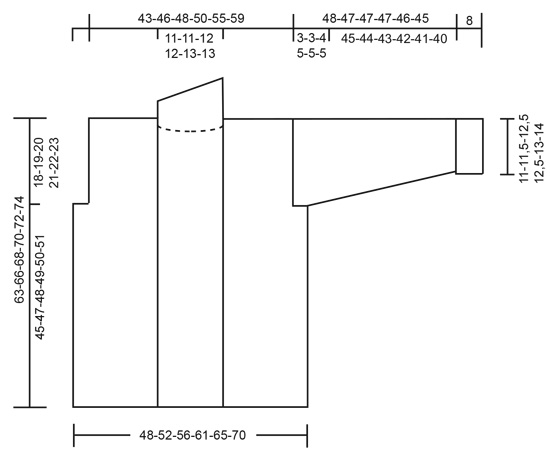
|
||||
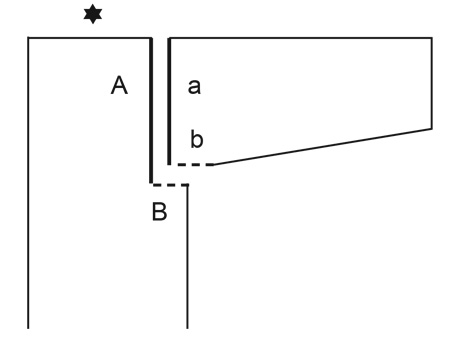
|
||||
|
Have you made this or any other of our designs? Tag your pictures in social media with #dropsdesign so we can see them! Do you need help with this pattern?You'll find tutorial videos, a Comments/Questions area and more by visiting the pattern on garnstudio.com. © 1982-2024 DROPS Design A/S. We reserve all rights. This document, including all its sub-sections, has copyrights. Read more about what you can do with our patterns at the bottom of each pattern on our site. |
||||







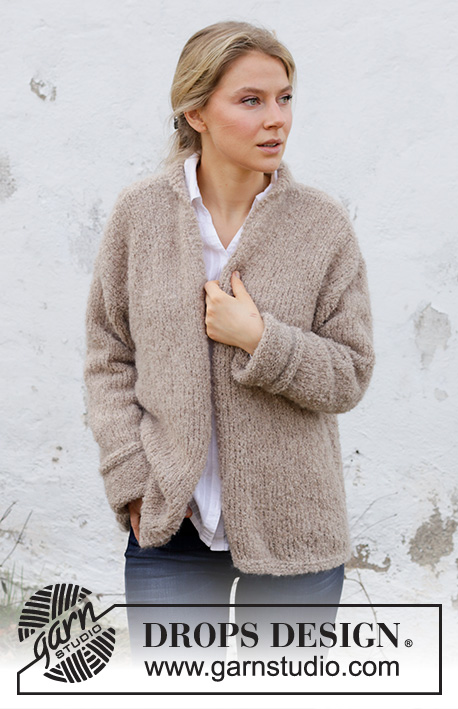
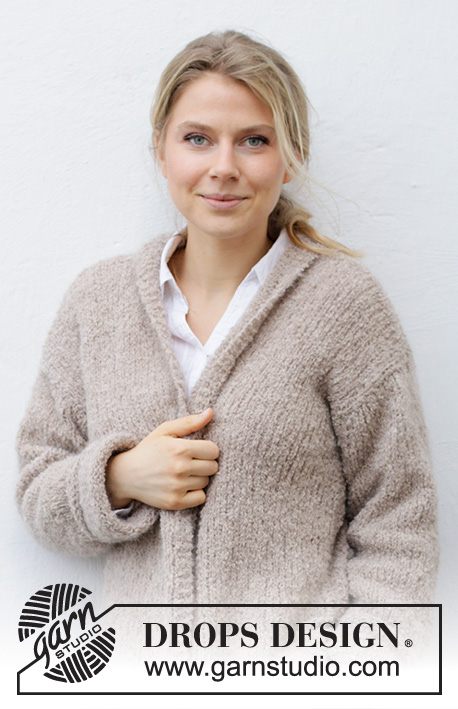

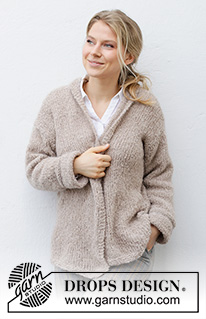
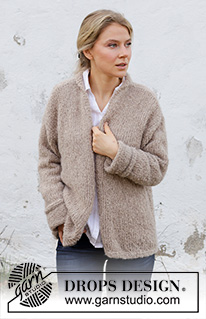
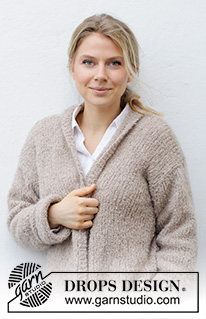


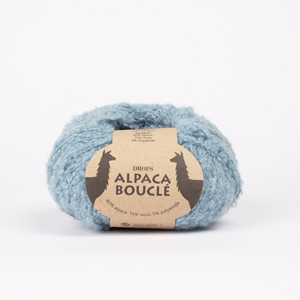
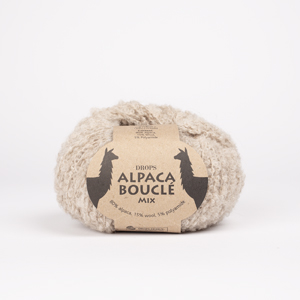




































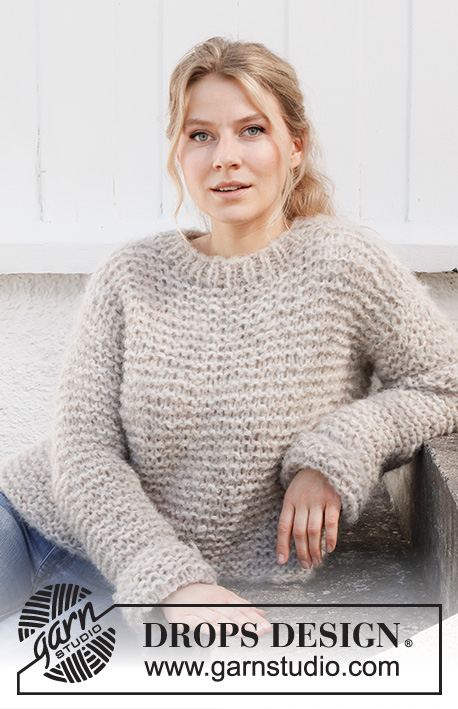






Comments / Questions (30)
Hej! Önskar ett mer formfast alternativ till Alpacka Boucle. Ska passa till Drops Kid Silk uni colour beige. Mvh Eva.
25.09.2023 - 09:10DROPS Design answered:
Hej Eva, da kan du bruge DROPS Alaska 49 som passer perfekt og er på tilbud eller så finder du en selv: Beige - garngrupp c
26.09.2023 - 15:46Where the pattern calls for 2 strands one each of drops alpaca bouclé and drops kid-silk and I would like to use only Bouclé should I reduce the needle size to 4/5 mm in place of 6/7mm and adjust for size (with a tension sample)?\r\nThanks you
18.09.2023 - 14:05DROPS Design answered:
Dear Mrs Roche, you will have to make your own swatch and recalculate the whole pattern - read more here - it might be easier to look at the pattern for a yarn group C, just as Alpaca Bouclé and with 1 strand - see here. Happy knitting!
18.09.2023 - 16:12Bonjour, Merci beaucoup pour vos modèles. Est-il possible d’avoir ce modèle en3XL ou 4XL?
16.05.2023 - 19:41DROPS Design answered:
Bonjour Lise, ce modèle ne va que jusqu'au XXL, mais vous trouverez ici tous nos modèles de gilets et vestes en XXXL, n'hésitez pas à ajouter des filtres pour affiner votre recherche. Bon tricot!
17.05.2023 - 08:05Hei Er strikket ermet til deit man skal sette 1 nytt merke i hver siden for å marker hvor bunnen av ermhullet starter. Oppskrift: Strikk vieder til ermet måler .....cm fra merkene nederst på ermet. Fell løst av fra retten. Sy bunnen av ermet? I følge dette vil jo ikke ermet passet inn i ermfellingen på bak- og forstykkene jmf diagramforklaringen. Hvordan skal dette forståes?
02.03.2023 - 16:12DROPS Design answered:
Hej Else Marie, jo da det stemmer, se skissen hvordan du syr sammen :)
08.03.2023 - 07:55Hi! Thank you for this beautiful model. Question - back and front are casted using 3 threads while sleeves are casted using 4. Why?
05.12.2022 - 00:22DROPS Design answered:
Dear Iuliia, you cast on the sleeves with 4 strands so that you will be sure to get an ealastic edge (needs to be more elastic on wrist than on bottom edge). Happy knitting!
06.12.2022 - 11:33@Katrien, voor de kraag heb ik geen 2 maar 1 ribbel gebreid voor de lange toeren. Succes !
19.11.2022 - 01:23Hallo, IVM de kraag : op 2/10/22 schreef u (aan Kathleen) dat u de ontwerpafdeling contacteerde om evt aanpassingen te doen? Ik wacht nu enkele weken om de kraag te breien, wacht ik nog, of heeft u tips voor mij, zodat de kraag mooi lukt. Ik lees hier dat bij velen die kraag niet lukt. Mvg
30.10.2022 - 18:33Bonjour je m'aperçois au moment de les assembler que les 2 morceaux du col st bcp trop longs... j'ai une encolure de 30cm env et 2 morceaux de col de 22cm. J'ai fait 9 fois 3 rangs de côtes et 1 rang envers comme indiqué pour taille M, les autres mesures st ok avec le modèle. Dois je refaire ? coudre froncé ? Merci de votre conseil Dominique Par contre la laine est très belle et le modèle très cocooning, top !
25.10.2022 - 17:58DROPS Design answered:
Bonjour Mme Masson, les deux parties du col doivent mesurer 7 ou 8 cm (cf taille) du côté le plus court (= côté épaule/ c'est le côté qui est cousu le long de l'encolure dos), de l'autre côté (côté bordure devant/ouverture de la veste), il sera 2 fois plus long à cause des rangs raccourcis, mais c'est le côté qui sera replié - cette vidéo montre un col châle sans rangs raccourcis (le côté le plus court est le côté où vous avez tricoté moins de rangs), en espérant qu'elle puisse vous aider. Bon tricot!
26.10.2022 - 07:38Er zijn hier al veel vragen gesteld ivm de kraag. Inderdaad, als je de instructies volgt heb je veel meer dan 8 cm aan de korte kant ( kant die aangenaaid wordt aan rugpand). Toch graag eens duidelijke instructies.
29.09.2022 - 02:04DROPS Design answered:
Dag Katleen,
Inderdaad lijkt het alsof er een fout in zit en dat je minder ribbels moet breien. Ik heb het doorgegeven aan de ontwerpafdeling om naar te kijken. Hopelijk komt er spoedig een correctie.
02.10.2022 - 16:14Must it be knitted on a circular kneedle or can regular kneedles be used !
26.06.2022 - 22:32DROPS Design answered:
Dear Mrs Vee, each piece is worked here with circular needle to get enough room for all stitches, but you will work all the way back and froth, so that you can use straight needles, the stitches will just be tighter. Read more here. Happy knitting!
27.06.2022 - 09:03